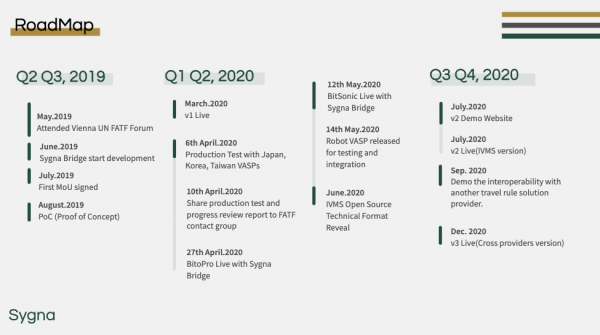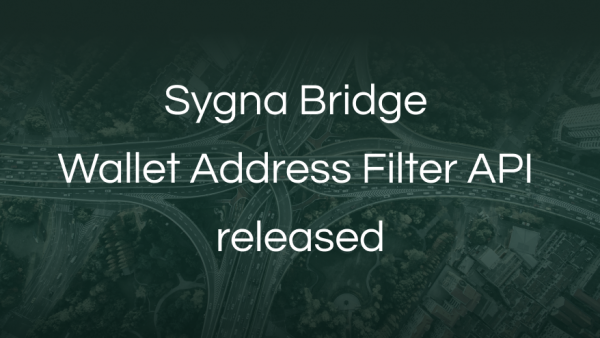This 3rd article in our Lens series reviews FATF Travel Rule solutions like Sygna Bridge with an Implementation lens to gauge installation and development progress.
Table of contents
- Introduction
- The importance of correctly implementing your Travel Rule solution
- Two Main Implementation Types of Travel Rule Solutions
- Suggested Implementation Benchmarks
- Sygna Bridge’s implementation process
Introduction
Welcome to the third part of our educational series on how to choose a Travel Rule solution by viewing them through 4 different lenses: Technology, Identification, Implementation, and Governance.
In this edition, Sygna product manager Vince Lee will review FATF travel rule solutions through the Implementation lens. We’re going to look at what benchmarks you can use to measure installation and development progress after you’ve made the decision to onboard with a Travel Rule solution like Sygna Bridge and others.
This article will assess different Travel Rule solutions by viewing them through the identification lens. We will focus on the following topics:
- A brief explanation of why implementation is important.
- An introduction to the two main types of Travel Rule solutions
- Some suggested Implementation benchmarks for perspective.
- How Sygna can help you with the implementation of our solution.
Read the previous articles in our Travel Rule Solution Lens series:
- Travel Rule Solution Lens 1: Technology
- Travel Rule Solution Lens 2: Identification
- The 4 FATF Travel Rule Lenses to Assess AML Compliance Solutions (Part 1)
- Travel Rule: Analyzing Sygna Bridge through Its 4 Lenses (Part 2)
View webinar:
View Google Slides Presentation
Part 1: Why is a Travel Rule Solution’s Implementation So Important?
There are two main reasons why implementation is important in a FATF solution:
- 1. Integration
- 2. Product Flexibility
- Firstly, you need to look at the integration effort. In the software development industry, if you have unlimited engineering resources, then obviously your project managers are not doing their jobs right. Especially to comply with the Travel Rule, there is always going to be a hard deadline for you to meet a compliance mandate.
- Secondly, you need to look at product flexibility. By Flexibility, I mean whether it is easy to maintain and is flexible for future migrations. System migrations and upgrades are very common in the fast-changing crypto industry. So it is important to choose a solution that is easy to implement with your limited resources and schedule, but the solution also needs to be flexible enough for future migrations.
Part 2: Two Broad Types of Travel Rule solutions
- Before making a decision, it’s important to review what types of solutions are in the market.
- For implementation purposes, there are two main types of solutions.
- Those that create new protocols, and those that do not.
1) Travel Rule messaging protocol provider
The goal of the Travel Rule messaging protocol provider is to create a new protocol and encourage the market to adopt this protocol and benefit from the network effect.
In Travel Rule, protocol providers often only design the communication interface between each VASP, such as the API interface for example but do not necessarily provide services that cover protocol implementation.
2) Integrated Software provider
Integrated software or application providers provide software that integrates with one or multiple Travel Rule protocols and offers integration consulting services. Their goal is to find business opportunities in the software industry.
To put it in simpler terms and to give you an example, let’s take the HTTP protocol and the web browser that you are using. HTTP is the internet protocol that helps you to connect with the resources shared in a public network. Web browsers like Google Chrome, Firefox, Safari, and Brave are the applications that run the HTTP protocol and present the resource in a friendly user interface.
However, some organizations provide both services, so being both a protocol provider and offering integrated software services.
For example, Sygna, Shyft, and Netki are both protocol and integrated software providers. Where TRISA, USTRWG, Travel Rule Protocol, and OpenVASP are only protocol providers, and Notabene, CipherTrace Traveler, and Coinfirm are integrated software providers.
The level of implementation support is different for each protocol and integrated software provider. Here is a review of the implementation benchmarks.
Part 3: Three Travel Rule Integration Benchmark Tools
Benchmark 1: The SDK
What kind of tools does each solution provide? In software development, engineers love Software Development Kits (SDKs). It helps them to connect with the solution without having to recreate the same functions. But, there is still a concern about the programming language.
The SDK needs to be matched with the programming language that your engineering team is using. So, the more languages supported, the better.
Benchmark 2: Testing
During the implementation, you will need a tool for the testing function because the Travel Rule requires interaction with a counterparty to transfer messages with you.
It is also important to have testing functions or robots to validate that the message you sent is in the correct format. This ensures maximum security when your system is moved to be in production.
2 Different Types of Software Implementation
There are two different types of software implementation: API interface, and client software.
API interface is designed for fast implementation, connections between servers are created when a sender sends the requests in a specific format to the receiver’s server endpoint. It is the most common technology in the current software industry because of its flexibility.
- 1. API interface
- 2. Client software
1. API Interface
API interface is designed for fast implementation, connections between servers are created when a sender sends the requests in a specific format to the receiver’s server endpoint. It is the most common technology in the current software industry because of the flexibility.
2. Client Software
Client software is software that is installed on the client server to perform functions and send requests automatically, which is very powerful but takes more time to install due to server configuration and spec conflicts.
For the Travel Rule, personal data has to be transferred so it needs to be encrypted before sharing.
The API interface usually pairs with the SDK to perform format translations and encryptions locally.
Client software is able to help you translate and encrypt formats while ensuring personal data is only retained locally on your server. This will also help in the future with interoperability.
Benchmark 3: Integration Support
Driving software development correctly is not an easy task. That is why product managers are so important in the industry.
Given how fast crypto regulation is changing, it is important to make sure that your engineering team is always kept informed. To ensure this, time zone and language are critical. We also suggest short but effective weekly touchpoint meetings to identify any issues and blockers during the integration process.
Just looking at the three different benchmarks is probably not enough to make an informed decision because software development is constantly evolving, access to resources varies, and you will need to know that the team you chose is able to meet the milestones that they promised.
But at least it gives you food for thought. So when you are looking at a solution through the lens of implementation, be sure to understand the tools they offer. Is it an API interface or client software, and what level of technical support can they realistically provide?
Part 4: Sygna Bridge vs Implementation Lens
- Sygna Bridge is an API-based, Travel Rule protocol designed for messaging transfer.
Currently, there are 4 SDKs that support the most common programming languages: Java, Javascript, Python, and Golang. - A robot VASP is provided for automation testing and format validation.
- As for the level of support, Sygna Bridge has 4 account managers distributed across the UK, Japan, Korea, and Taiwan to deliver customer support for the integration process and we will add more as demand ramps up.
- We are highly skilled in project management, which we drive through weekly meetings to identify any integration blockers and issues.
- If there is a technical issue, we can deploy a full development team with full-stack, testing, site reliability, and DevOps engineers to replicate issues and identify root causes.
In June and December 2021, we will be rolling out our integrated software solution for holistic compliance of Travel Rule, blockchain analytics, sanction name screening services, and multiple Travel Rule protocol integrations.
What is Sygna Gate?
Sygna Gate will be launched in Q3 as our SaaS version for smaller VASPs or OTC trading companies that do not have the technical resources to integrate and only perform compliance checks manually on the provided website interface.
What is Sygna Hub?
Sygna Hub is a soon-to-be-released client software version for VASPs who want to have full control over personal data and automation compliance checks.
These developments are in response to client demand and we are working continuously to provide new services to meet the changing needs of the market. We aim to help you meet your regulatory requirements and we will grow with your needs.
We hope that we’ve provided you with more insights to assist you in your journey to Travel Rule compliance.
If you’d like to know more, please feel free to contact us at services@sygna.io
This session was prepared by Vince Lee, product manager for CoolBitX, on behalf of the Sygna product.

About CoolBitX
CoolBitX is a Taiwan-based blockchain security company that was founded in 2014, we have two main lines of business, the first is a Bluetooth hardware wallet and the second is a technical solution for the travel rule called Sygna Bridge. Thanks for listening. See you in the next 4 lens sessions.


